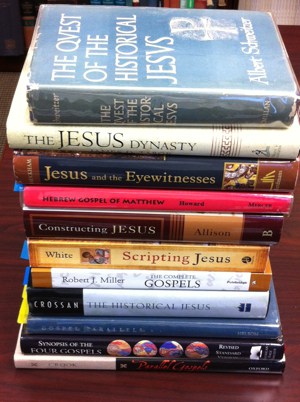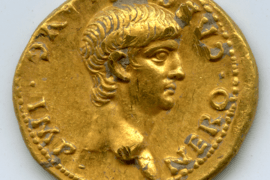I recently wrote a post titled “Do Historians Exclude the Supernatural?” Here I want to explore a related issue that one often hears from a variety of circles also having to do with methods of the academic study of religions–how scholars evaluate ancient texts–and here I will particularly focus on my own work on the historical Jesus.
When it comes to a critical reading of our New Testament gospels and other related texts one can get the impression that scholars end up rather arbitrarily “picking and choosing” whatever they want–especially in trying to construct their portraits of the “historical Jesus.” In other words, as Albert Schweitzer cautioned long ago, all too often historians seem to come up with a Jesus made in their own image, so that texts and traditions they favor are retained whereas those they disfavor are discarded as unreliable. In fact, I would argue that more often quite the opposite is the case. Many of those who claim simply to “take the Bible as it is,” without any critical discernment of sources, traditions, and historical contexts actually end up as the ones who quite arbitrarily fall into this trap of subjectively “picking and choosing.”

For example, we have two very different versions of the so-called Beatitudes–Matthew 5:1-12 and Luke 6:20-26. The same is the case for the Lord’s Prayer–compare Matthew 6:9-13 and Luke 11:2-4. Matthew’s version is by far the one best known, most often quoted, and clearly favored by most Christians–but what about Luke’s alternative version? How and why is it different and what can we make of those differences? Why do we have differing versions of many of Jesus’ teachings and sayings in Matthew and Luke that are not in Mark–this is the “double tradition” that most scholars refer to as Q. Rather than picking ones “favorite” version, and using it arbitrarily for ones own purposes, what critical scholars attempt to do is analytically account for the various strands of tradition, carefully comparing the similarities and differences, in an effort to get at why our traditions differ, when and where they originated, and which might more reliably go back to Jesus himself–if such can be determined. I often tell my students, a critical reading of our sources means a careful reading, with great attention to differences and details. Many of those who claim that they simply “take the Bible as it is,” in fact have never carefully read the very texts they claim to honor and are blissfully unaware of the important differences in our various sources.
As an illustration take a look at my post on the various differing accounts of the discovery of Jesus’ empty tomb following his crucifixion, “How Faith in Jesus’ Resurrection Originated and Developed.” Rather than arbitrarily choosing the one I liked best, I tried to arrange them in their most likely chronological order and to account for the differences in terms of the obvious rewriting and overwriting of earlier sources by later ones.
So how do historians go about doing their work? What methods and principles do they value and seek to follow?
To begin with, historians do not privilege any texts, be they in or out of the Bible, as inherently reliable based on a view of divine inspiration. This method immediately separates historical work from theological work, in that theology, at least traditional Christian theology, begins with the assumption that the texts of the Bible are inspired and thus at some level “true” or at least “more true” than other writings of the time. For the historian there is a sense in which all texts are created equal and are therefore examined with the same methods of analysis. That does not mean, however, that some are not considered more accurate historically than others. For example, when it comes to reliable history or teaching of Jesus most scholars would not give as much weight to the Gospel of Thomas as the Gospel of Mark. Often this has to do as much with dating and chronology as to whether a text is “in” the New Testament or not. Thomas, like the newly published Gospel of Judas, dates from the late 2nd or early 3rd century whereas Mark seems to have been written around 70 CE–within forty years of Jesus’ lifetime.
Older is not always better, but when we have a text as old as Mark, we surely want to give it the priority that it deserves. And we can show how Mark becomes the narrative core or basis for both Matthew and Luke, who “overwrite” and “rewrite” it with their own interests in mind. This does not mean, necessarily, that anything from Matthew’s and Luke’s “rewritten Mark” has no historical value, but it does allow us to account for how and when the various differences arose, and often we can trace them to particular emphases or interests of the authors. For example, Luke consistently removes, time and time again, the motif, so dominant in Mark, of the failure of the disciples. Those sections of Mark are simply missing in Luke–he purposely and consistently takes them out (e.g. Mark 8:32-33; 10:35-40; 14:32-50).
It is also possible that the “double tradition” in Matthew and Luke, that most scholars refer to as Q, might well predate even Mark. It appears to be an early collection of the teachings of Jesus with a minimum of narrative material. Chronology is not everything, but at least in the beginning we want to try to arrange our sources as much as possible in a chronological fashion, thus when it comes to Jesus we have: the Q source, Mark, Matthew, Luke, the “Signs source,” John, the letter of James, the Didache, fragments of the Gospel of Peter, fragments of “Hebrew Matthew” and the gospel of Thomas, even though scholars might disagree as to their precise dating. Surprisingly, to many, the letters of Paul are earlier than any of these gospel materials and one of our latest sources, which is mistakenly taken by many as the most foundational text for the development of the early Christian movement, is the book of Acts.
It is also important to try and detect the kind of editorial development that goes on in such a trajectory of texts. It is not always strictly chronological, but often it is. On the whole we can see, within the early Christian tradition, a tendency to make Jesus more divine and less human, to downplay the role of John the Baptist, and to mute or mitigate the role of James and the family of Jesus. What we try to do is to take all our sources and compare them side by side and then to draw conclusions, as much as we can, as to what is most likely closer to Jesus and what might be a later development.
To take just a few examples, Matthew uses Mark as a source and he consistently “edits” him at crucial points. In Mark 10:17-18 a man says to Jesus “Good teacher, what do I do to inherit eternal life?” and Jesus rebukes him replying, “Why do you call me good, there is One who is good, God.” Matthew comes to that story and alters Jesus’ answer to read: “Why do you ask me about the good.” Here you can see that given Matthew’s more divine view of Jesus, he finds the wording of Mark troubling and freely edits it. When it comes to Q there are times when the Hebrew version of Matthew appears to be less edited than the Greek versions in either Matthew or Luke. A prime example is Matthew 11:11 (Luke 7:28) where Jesus declares that “among those born of women there is none greater than John.” This startling statement stands unqualified in the Hebrew version of Matthew preserved by Ibn Shaprut, whereas in Greek, both Luke and Matthew have the qualifying addition: “but nonetheless, the least in the kingdom of God is greater than he.” I am convinced that the latter is an editorial gloss that was added to soften the shocking implication that John the Baptist is then greater than Jesus. In such a case we often give the more difficult, or the more “primitive” reading more weight than what appears to be a later addition. The issue of Jesus being baptized by John is one of the clearest examples one can find of the unfolding tendency to elevate Jesus above John. Mark offers a straight account of John Baptizing Jesus, Matthew adds the lines in which John objects to doing this since Jesus is greater, Luke reports Jesus’ baptism and implies John did it, but never directly says so, and John drops the entire narrative account entirely. Most of us are convinced that this kind of evidence can not be dismissed as chance and it should not be ignored but carefully analyzed.
This entire process can appear to a casual reader as “picking and choosing” at will, but it is in fact a carefully worked out process. In my book, The Jesus Dynasty, I try to bring the reader into the methods of analysis I employ so as to make clear why certain texts and traditions are thought to be more historically reliable while others are seen as secondary. In our book, The Jesus Discovery, coauthored with Simcha Jacobovici, that process continues. The book begins with our new archaeological discoveries at the Talpiot tomb but it is much more than that, with two thirds of the book devoted to a careful and critical analysis of a set of related issues–who was Mary Magadelene? What about the accounts of the “empty tomb”? What role did James the brother of Jesus play in early Christianity? How do Paul’s letters contribute historically to our understanding of Jesus?–as well as many others.
What we historians attempt is not a perfect lab science–if such a thing exists–but there is a method to what might appear to some to be “madness.” I want to invite my readers into the process of critical evaluation and reflection; the same process that I use with my students and that is commonly followed in advanced courses in universities when one deals with the historical Jesus. Once one carefully works through the arguments presented in both The Jesus Dynasty and more recently in The Jesus Discovery, I think one might find that what seems at first glance to be “picking and choosing” is actually a rather careful methodological attempt to sort through the sources in a responsible historical manner.








Comments are closed.